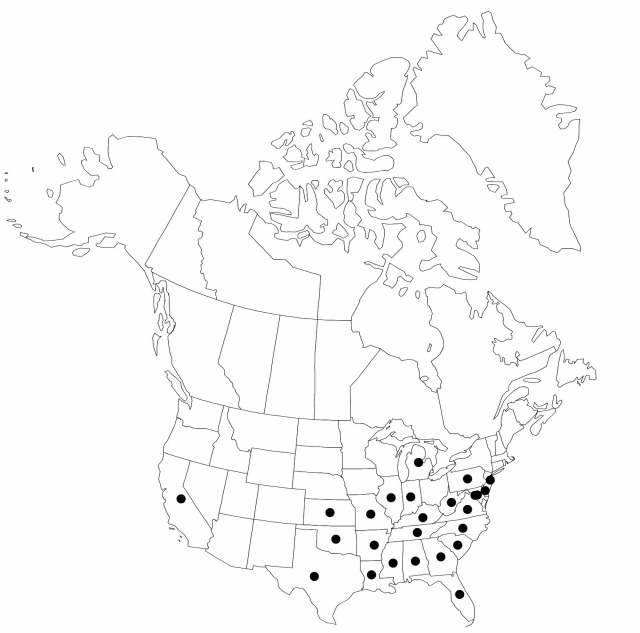Difference between revisions of "Rhynchospora recognita"
Novon 9: 205. 1999.
FNA>Volume Importer |
FNA>Volume Importer |
||
| Line 10: | Line 10: | ||
|name=Rhynchospora globularis var. recognita | |name=Rhynchospora globularis var. recognita | ||
|authority=Gale | |authority=Gale | ||
| + | |rank=variety | ||
|publication_title=Rhodora | |publication_title=Rhodora | ||
|publication_place=46: 245. 1944 | |publication_place=46: 245. 1944 | ||
| Line 16: | Line 17: | ||
|name=Dichromena cymosa | |name=Dichromena cymosa | ||
|authority=(Elliott) J. F. Macbride | |authority=(Elliott) J. F. Macbride | ||
| + | |rank=species | ||
}} {{Treatment/ID/Synonym | }} {{Treatment/ID/Synonym | ||
|name=Phaeocephalum cymosum | |name=Phaeocephalum cymosum | ||
|authority=(Elliott) House | |authority=(Elliott) House | ||
| + | |rank=species | ||
}} | }} | ||
|hierarchy=Cyperaceae;Rhynchospora;Rhynchospora recognita | |hierarchy=Cyperaceae;Rhynchospora;Rhynchospora recognita | ||
| Line 43: | Line 46: | ||
-->{{#Taxon: | -->{{#Taxon: | ||
name=Rhynchospora recognita | name=Rhynchospora recognita | ||
| − | |||
|authority=(Gale) Kral | |authority=(Gale) Kral | ||
|rank=species | |rank=species | ||
| Line 58: | Line 60: | ||
|publication year=1999 | |publication year=1999 | ||
|special status= | |special status= | ||
| − | |source xml=https://jpend@bitbucket.org/aafc-mbb/fna-data-curation.git/src/ | + | |source xml=https://jpend@bitbucket.org/aafc-mbb/fna-data-curation.git/src/f50eec43f223ca0e34566be0b046453a0960e173/coarse_grained_fna_xml/V23/V23_395.xml |
|genus=Rhynchospora | |genus=Rhynchospora | ||
|species=Rhynchospora recognita | |species=Rhynchospora recognita | ||
Revision as of 20:07, 16 December 2019
Plants perennial, cespitose, 60–100(–120) cm; rhizomes absent. Culms leafiest at base, trigonous, slender, somewhat stiff. Leaves exceeded by culms; basal blades spreading, blunt, distal ascending, linear, proximally flat, 2–5 mm wide, apex trigonous, subulate, tapering. Inflorescences: spikelet clusters 3–5 or more, compact, proximalmost widely spaced, turbinate to hemispheric or lobed; peduncles ascending, branches ascending; leafy bracts setaceous at apex, exceeding compounds, setaceous bracts often exceeding ultimate clusters, imparting bristly aspect. Spikelets redbrown, ovoid to lanceoloid, (2.7–)3–4 mm, apex acuminate; fertile scales ovate, 2.5–3 mm, apex acute, shortacuminate, or notched, midrib usually excurrent as cusp or awn. Flowers: perianth bristles 6, not reaching further than fruit midbody. Fruits 1–3 per spikelet, (1.8–)2–2.3(–2.5) mm; body brown, tumidly lenticular, obovoid to suborbicular, 1.4–1.6(–1.8) × 1.2–1.5 mm; surfaces transversely sharply rugose, intervals of rows of vertical, variously rectangular alveolae; tubercle somewhat compressed, triangular to shortconic, 0.5–0.7 mm, shortsubulate, basal rim often present.
Phenology: Fruiting spring–summer(–early fall).
Habitat: Sands, silts, clays, and peats of low meadows, ditches, low clearings, savannas
Elevation: 0–400 m
Distribution

Ala., Ark., Calif., Del., D.C., Fla., Ga., Ill., Ind., Kans., Ky., La., Md., Mich., Miss., Mo., N.J., N.C., Okla., Pa., S.C., Tenn., Tex., Va., W.Va., West Indies, Central America.
Discussion
Rhynchospora recognita has larger fruit and tubercles than is consistent with the varietal rank it has held under R. globularis. The two are often observed in the same locality, and in such cases, R. recognita is taller, stiffer, broader leaved, with spikelet clusters wider, denser, and bristlier, and with distinct orange tints in comparison with the darker, less dense, narrower, and less bristly spikelet clusters of plants of R. globularis.
Selected References
None.
